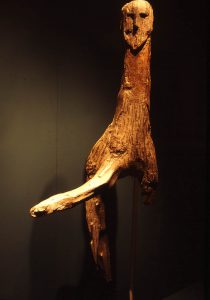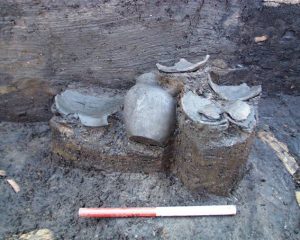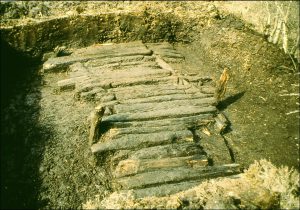More info
The bogs and the gods
For a person from the Iron Age, the bogs must have been an unsettling place full of mystery and danger. Not water, but not land either. Ever since the Neolithic Era, people have connected the bogs with something cultic or at least done things that we perceive as being religious-related rituals. From the Iron Age, we have many testimonies about religious practice, ranging from the deposits of simple food offerings, through sacrifices of precious jewelry and silver- and bronze cauldrons, to weapons and human sacrifice. Wooden statues found in bogs and wetlands are also interpreted as effigy of gods. Therefore, there is no doubt that Iron Age people considered the bogs to be special places. Places to connect with the gods. What kind of gods they believed in back then, we do not know.
Wooden-paved plank roads have sought to make transportation across the bogs much safer as people also went about there. Among other things, people were digging peat as fuel, but more important was probably the access to limonite, the raw material of iron. Old turf workers also inform that Bjældskovdal similarly had a plank road. One of the single vertical poles, which stood in pairs for every meter, has been preserved for present days and is estimated by a carbon 14 dating to be from 800-350 B.C., that is, Late Bronze Age. With some necessary repairs, it could easily have functioned at the time of Tollund Man a couple of hundred years later. We can imagine that it was alongside this road that they were digging peat, and perhaps they even used the same road when they carried Elling Woman and Tollund Man out to their peat graves – as sacrifice of thanks to the gods who gave them limonite and peat.
- Autopsy at Bispebjerg Hospital
- Carbon-14 dating
- Conservation of Tollund Man
- Excavation and the preliminary investigations
- How did Tollund Man die?
- How Tollund Man was discovered
- New analysis of Tollund Man’s stomach contents
- Other bog bodies
- Peat cutting in recent times
- Peat spades
- People, bogs and gods during Iron Age
- Recreating Tollund Man
- Roman sources on punishment and sacrifices
- The bogs and the gods
- Tollund Man in brief
- Tollund Man’s brain is well preserved.
- Tollund Man’s last meal
- Was Tollund Man a sacrifice to the gods?
- What can Strontium isotope analysis tell about Tollund Man?
- Were bog bodies sacrifices to gods?
- Why was Tollund Man hung?


